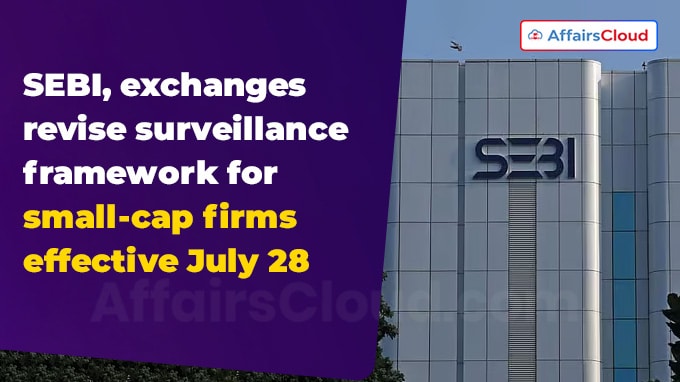 In July 2025, the Securities and Exchange Board of India (SEBI), along with stock exchanges, has revised the enhanced surveillance mechanism (ESM) for companies with market capitalisation under Rs. 1,000 crores with an aim to improve oversight of small and micro-cap stocks.
In July 2025, the Securities and Exchange Board of India (SEBI), along with stock exchanges, has revised the enhanced surveillance mechanism (ESM) for companies with market capitalisation under Rs. 1,000 crores with an aim to improve oversight of small and micro-cap stocks.
- These revisions, expected to benefit 28 companies currently under the surveillance framework, will take effect from July 28,2025.
Key Highlights:
Background: The ESM framework was initially extended to listed companies with a market capitalisation of under Rs.1,000 crore in August 2023, as part of SEBI’s efforts to curb excessive price volatility and speculative trading.
- SEBI and the exchanges conduct weekly reviews to evaluate if a stock should be downgraded to a lower stage or removed from the framework entirely.
Objective: The ESM framework is designed to strengthen market integrity and investor protection, especially in the case of small and micro-cap stocks, which are more prone to sharp price movements and speculative interest.
- It aims to identify and address potential risks associated with stocks exhibiting unusual price fluctuations.
Stage 1: Previously companies were brought under surveillance mainly due to high-low price variation metric.
- But under the current revised ESM framework, apart from the above metric, a sustained upward close-to-close price trend over the last three months will now be considered.
- This addition aims to better detect consistent price increases, often signaling growing investor interest in the stock.
Stage 2: A new price-to-earnings (PE) ratio filter has been introduced to determine if a stock should move from Stage 1 to Stage 2 under the ESM framework.
- Only stocks with a PE ratio up to twice that of the Nifty 500 index will qualify, ensuring that excessively overvalued stocks come under stricter surveillance.
- This is done to prevent market manipulation and protect investors from risky stocks that may be overhyped or overvalued.
Restrictions: Companies placed under Stage 1 of ESM face a 100% margin requirement starting from T+2 days, and a trade-for-trade settlement mechanism with a 5% price band, i.e. the price of a security can fluctuate up or down by a maximum of 5% of its previous day’s closing price within a single trading session.
- In case, if a stock already operates under a 2% price band, that restriction will remain unchanged.
Important Terms:
- PE Ratio: It is the ratio of the current price of a company’s share in relation to its earnings per share (EPS).
PE Ratio = Market Price (Per Share) / Earnings Per Share (EPS)
- Close-to-close price trend: It refers to the percentage change in a stock’s closing price from one trading day to the next.
About Securities Exchange Board of India (SEBI):
Chairman – Tuhin Kanta Pandey
Headquarters – Mumbai, Maharashtra




